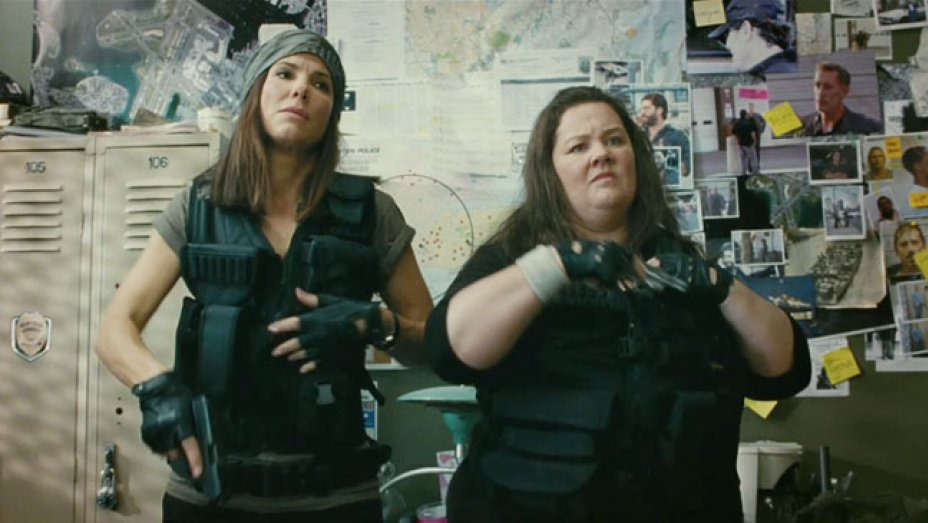The epitome of Millennial Feminism in Hollywood
@SunetraSenior

Summer, a time of soaring temperatures and July 4th festivity, has definitely come to an end, but not to worry, Katie Dippold’s action-comedy, The Heat, is around to revive it! Sandra Bullock stars as uptight FBI agent, Ashburn, while Melissa McCarthy plays her unruly yet street-smart associate as the gritty cop: Mullins. The film is a current tribute to the progress of women’s equality through its disobediently dynamic female representation on the big screen. It builds on Hollywood’s success of Kristen Wiig’s Bridesmaids (2011) in that it forwards women’s experience as an equally legitimate narrative to that of typically phallocentric accounts. In Bridesmaids, for example, as opposed to focussing on the resolution between a heterosexual couple who then happily marry, the film explores the highly sentimental nature of women’s friendships and delves into that bond.
Dippold’s The Heat emerges as the defiant feminine counterpart to testosterone-filled cop comedies such as Die Hard (1988) Bad Boys (1995) and The Other Guys (2010). Another comparable screenplay is Abbi Jacobson and Llana Glazer’s Broad City, written for TV’s Comedy Central, following the hijinks of two women in their early twenties trying to make it in New York after they graduate. Whether they relate to sexual, romantic or aspirational worlds, respective plots have started to place women at their centre. It helps that the writers behind the influential keyboards are increasingly women too! Sporting guns, gore and an explicit gender commentary, The Heat is a particularly bold Feminist piece.
Not only are the protagonists two independent women, but also placed in the most masculine role within a civic context imaginable: physical protectors of the state. In one scene, a knife is plunged into agent Ashburn’s leg not once, but twice: unthinkable to the James Bonds of the past. No more is the damsel in distress or the admiring female accomplice. These archetypes have not so much left as been shot and buried beneath the building. Held captive by a drug ring, the only way for the two female officers to escape is to re-impale an instrument of torture as if it were never moved to catch their attackers by surprise. They then not only drive, but also contain the action, no matter how heated (oop) it gets. The sexist convention of perceiving women as inferior is voiced by two disgruntled male colleagues throughout. They essentially espouse the mantra: ‘nothing gets done when we let women in.’ Of course, this only makes victory all the more explosive when Ashburn and Mullins do end up showing ‘em what for. The relationship that the two women share is also very telling. Ashburn pushes for that promotion while Mullin fights to save her brother from serving a second sentence in jail, but the two are more than just a female rendition of the typical brains and brawn pairing. The tension between their disjunctive characters portrays a timely shift in the fight for women’s equality. In 2014, female autonomy goes deeper than the achievement of professional parity in the workplace. Having proven the obvious truth that both genders are equally capable as different women thrive across a variety of sectors, the Feminist movement moves to a revisional new stage: claiming absolute personal freedom.
This is the height of Third Wave Feminism, setting the precedent for the Fourth. This we see reflected in the physical comfort of Mullins who promotes more than just a positive body image. Completely spatially liberated, she takes what is due to her socially and not just what is stipulated in the bureaucratic dictate of legislation. She authorises herself outside of the need for institutional masculine validation. This is to be truly emotionally strong. In Mullins’ first scene, for example, she is shown in baggy casual clothes, nonchalantly strolling up to a man who is about to purchase sex to straightforwardly ask: “what’s happening here, huh?” Later, she dives through two parked cars in order to exit hers, shortly throwing open the door to her boss to announce to the office: “has anyone seen his balls?” As opposed to sitting back in sycophantic gratitude, the movie relishes the raw zeal of the First Wave of Feminism which established the right of women to vote throughout the West. Indeed, by contrast Ashburn’s tightly kept femininity is a personification of the potential stagnation if vocational prowess was the ultimate main goal. She continues to play by the assumed rules of departmental etiquette, wearing the pant suits that a woman who takes her job seriously should wear and follows departmental procedure to the point of painful self-obstruction. Ashburn’s fellow male officers even laugh at the severity. In short, The Heat promotes the exercising of fully-fledged subjectivity to the utmost extent: not only challenging but also empoweringly dissolving the heavy hierarchy of patriarchy. The witty yet especially buoyant dialogue is an extension of this idea. As well as being flat-out funny, there is implicit advocacy of the importance of frank and candid self-expression to forward the Feminist movement.
Led by Mullins, the two law enforcement officials are shown bantering and opining in addition to the high-octane trajectory of their careers. The bit where Ashburn tries to arrogantly assert her authority, stating “I am a federal agent,” to an everyday barfly and is unexpectedly shot down is a particular jewel: the rugged stranger responds: “Well I got news for you d***, I work for the postal service. That makes me a federal agent too.” In another memorable scene, It’s Always Sunny in Philadelphia’s Kaitlin Olson makes a hilariously vocal appearance as a drug supplier who happens to live in the same public housing as the mouthy Mullins. The two have a fizzingly entertaining exchange. Here, Dippold’s film also playfully accounts for the complexity of what defines women’s equality today; the depiction of millennial womanhood never erring on simplistic. The proudly local, outspoken Mullins heralds a modern intersectional autonomy, which latently cuts across class to fiercely champion inclusion.
When Ashburn finally does switch to the unorthodox tactics of her partner then, surrendering to the cathartic chaos, swearing and going rogue on their big case, it is a consummate celebration of the core of contemporary Feminism: being fundamentally uninhibited to not only help oneself, but also be organically closer to the many different identities that the democratic movement is meant to represent as a result. As underscored by the loving message that Mullins mutually leaves for Ashburn at the end, the fight for gender equality is as much about the preservation of sisterhood as it is staking out individual independence. A cause should never alienate the people it campaigns for. Indeed, conversely, the male police officers in the movie end up turning on each other because their cold egos are short-lived: a selfish concept of solidarity being inherently flawed. It is emphasised that narcissism is only a destructive reinforcement. The emotional climax of the film shows Ashburn gleefully psychologically merging with Mullins to emerge as new ideological partners in crime. She may not have accomplished the most senior respected status, but has gained a valuable ally. Friendship prioritised; the two agents can even finish each other’s quips!
Finally, wider collaborative force is advocated in the movie’s meeting of traditional femininity in the middle. In an early moment in the film, Mullins jokingly undresses, or mildly assaults, her dowdy partner to make her more presentable to the bar scene: “And what is this sh**?”, she asks Ashburn about a prudish hair clip. Being invested in one’s appearance can be elevating if it is pure expression of personality over an unconscious performance of sexual subservience. Indeed, once toxically regulatory norms such as the gendered realm of fashion have become a welcome part of women’s day to day life in a philosophically emancipated context. Feminine identity has become more a choice over an imperative in recent years. Similarly, one can absolutely take pride in cultivating career so long as basic social liberty remains intact. Mullins is as proficient as Ashburn, but on her own idiosyncratic terms. Indeed, when Ashburn pipes up that she looks quite shoddy for someone so passionate about personal style, Mullins tellingly points towards a profounder marker of livelihood: “I don’t need to worry: I put my sexuality out there through movement.”
There is acknowledgement that the face of female strength can vary with a vibrant inner foundation. Shouting its triumphant message through engaging fiery exploits, The Heat commemoratively captures feminism in the advent of the new millennium. Appealing to both men and women, it galvanises the women’s movement through the universal medium of lively cinema: it is Rachel Talaley’s Tank Girl (1995) regenerated for the mainstream. With action-packed storytelling that’s also progressive, you’ll not only be chuckling at a vibrant comedy but also taking a meaningful stand.

Sunetra (Sunny) is an indie journalist, actress and short film writer. She is a popular columnist at a London weekly, and writes extensively on social democracy, Feminism and the psychological nuances of modern society. Her movies have been screened at the London Short Film Festival (LSFF) and Bristol Independent Short Film Festivals (BISFF).
Her progressive, perceptive writing cuts across film, current analysis and media. Known for its unerring emotional intelligence, the work focuses on the socio-politically urgent yet unseen. She enjoys combining arts, news and mindfulness to create a unique perspective, championing social change. In 2019, she was published in Oxford University’s journal, PHENOTYPE, investigating the relationship between apex dinosaurs and modern economy!
Sunetra specialises in the area of psycho-social evolution. To this end, her Sunshine Reviewing column salutes film, television and media that radiate a uniquely joyful message. Enjoy!
T: @SunetraSenior

